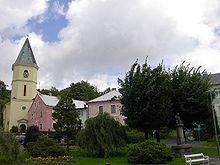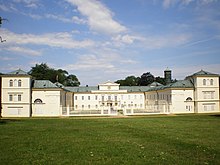Lázně Kynžvart
| Lázně Kynžvart | ||||
|---|---|---|---|---|
|
||||
| Basic data | ||||
| State : |
|
|||
| Region : | Karlovarský kraj | |||
| District : | Cheb | |||
| Area : | 3257.9589 ha | |||
| Geographic location : | 50 ° 1 ′ N , 12 ° 37 ′ E | |||
| Height: | 673 m nm | |||
| Residents : | 1,474 (Jan 1, 2019) | |||
| Postal code : | 354 91 | |||
| License plate : | K (old CH) | |||
| traffic | ||||
| Railway connection: | Plzeň – Cheb | |||
| structure | ||||
| Status: | city | |||
| Districts: | 2 | |||
| administration | ||||
| Mayor : | Miloslav Pernica (as of 2018) | |||
| Address: | náměstí Republiky 1 354 91 Lázně Kynžvart |
|||
| Municipality number: | 554600 | |||
| Website : | www.laznekynzvart.cz | |||
| Location of Lázně Kynžvart in the Cheb district | ||||

|
||||
Lázně Kynžvart (German Bad Königswart ) is a town with a spa area only for children at the foot of the Kaiserwald in Okres Cheb , Czech Republic .
geography
Geographical location
The city is located in western Bohemia on the western slope of the Slavkovský les ( Imperial Forest ), whose highest peaks, the 983 m high Lesný ( Judenhau ) and the 982 m high Lysina ( bald head ), are in the immediate vicinity of the town.
A prominent part of the city is the spa area, which is based on natural mineral springs and moorland.
City structure
Lázně Kynžvart consists of the districts and cadastral districts Lázně Kynžvart ( Bad Königswart ) and Lazy ( Perlsberg ). Basic settlement units are Lázně Kynžvart, Lazy and Zámek Kynžvart ( Königswart Castle ). To Lázně Kynžvart also includes the settlement Lískovec ( Haselhof ).
history
The first written mention of the castle comes from the year 972, when Emperor Otto I handed over a fortified complex and an extensive area to Bishop Wolfgang von Regensburg.
King Přemysl Ottokar II had a Kunigeswart castle rebuilt in the 13th century . In 1387 Heinrich IX bought von Plauen took over the rule of Königswart from Landgraves Johann and Albrecht von Leuchtenberg . As early as 1392, the lordship was in the possession of the noble Boresch (Borso) von Riesenburg , who in turn pledged it to the Hückler brothers, rich citizens from Eger. From around 1400 the rule was again owned by Henry IX. von Plauen, who passed them on to his descendants.
During the time of the Hussite Wars, the rule was devastated several times. a. 1430, when the Hussites also destroyed Plauen. When Margarethe von Plauen, a daughter of Heinrich I von Plauen , Burgrave of Meissen, married Hynek Kruschina von Schwamberg, she received the rule of Königswart as a dowry. Around 1440 there was a dispute with her brother Heinrich II over Königswart. In 1448 the place received market rights . After Margarethes death, the rule fell back to the Plauener apparently after 1464, because in 1506 Heinrich III. forcibly expelled from the Königswart dominion by the von Gutenstein brothers.
They were followed by the Pflugk to Rabenstein . After the Rabensteiners were driven out as a result of the defeat of the Protestants in the Schmalkaldic War and the bloody state parliament of Prague in 1547, rule fell to the Lords of Zedtwitz and Liebenstein. This Franconian-Bohemian family had a renaissance fort, the later renaissance castle Kynžvart, built below the place Königswart at the end of the 16th century . After the battle of the White Mountain in 1620, the rule was confiscated. Between 1623 and 1631 the Metternichs acquired the rule of Königswart, which remained in the family's possession until 1945.
In 1648, shortly before the end of the Thirty Years' War, Swedish mercenaries devastated the rule, among other things they destroyed the old Plauen castle on the 821 meter high castle hill above the town, which has since been in ruins and the remains of which can still be visited. One of their visitors was also Johann Wolfgang von Goethe.
From the middle of the 19th century, Bad Königswasser formed a municipality in the judicial district of Bad Königswart , the city being the seat of the judicial district.
After the First World War , Bad Königswart was added to the newly created Czechoslovakia . Due to the Munich Agreement of 1938 place came to the German Reich and was until 1945 the district Marianske Lazne , Region of Eger , in the Reich District of Sudetenland . In 1945 the German population was expropriated and expelled based on the Beneš decrees .
Population development
Until 1945 Bad Königwart was mostly populated by German Bohemia , which were expelled.
| year | Residents | Remarks |
|---|---|---|
| 1785 | k. A. | 177 houses |
| 1830 | 1540 | in 218 houses |
| 1847 | 1669 | in 209 houses, of which 24 houses are inhabited by 46 Israelite families |
| 1900 | 2039 | German residents |
| 1921 | 1861 | 1752 of them are German residents |
| 1930 | 1858 | |
| 1939 | 1771 |
| year | 1970 | 1980 | 1991 | 2001 | 2003 |
|---|---|---|---|---|---|
| Residents | 1368 | 1468 | 1655 | 1620 | 1647 |
politics
coat of arms
The coat of arms from the 15th century is split in red and silver, covered with the upper part of a golden lion, which comes from the Plauen coat of arms.
Town twinning
The twin town of Bad Königswart is Bad Bocklet ( Germany ).
Culture and sights
Buildings
- Königswart Palace in the style of Viennese classicism.
- The parish church (St. Margaret) was first mentioned in 1372, it was rebuilt in 1509 and in the second half of the 19th century. The statue of John of Nepomuk stands in front of the church .
- National cultural monument Dlouhá stoka (German raft ditch , translated long canal ).
- There is a Marian column on the market .
Green spaces and recreation
- Holina nature reserve on the southern slope of the Kaiserwald .
Regular events
- Annual blessing of the mineral springs, combined with a big children's festival in June.
- St. Margaretha fair in July.
Economy and Infrastructure
Spa
Medicinal water was mentioned for the first time in 1454, but the history of the health resort goes back further. The bathhouses were built in the middle of the 19th century. Carbonated and iron-containing drinking springs, carbonated, moor and iron baths were used. The Viktorsquelle is one of the strongest sources of iron in Central Europe. The indications were rheumatism, gynecological and nervous diseases and blood diseases.
Until 1950, only adults came to the cure for almost 100 years. Since then, the spa facilities have been designed for young patients suffering from diseases of the upper respiratory tract and skin diseases.
traffic
The city lies on the Plzeň – Cheb railway line .
Sons and daughters of the place
- Johann Nepomuk Stephan von Sacher (1759–1836), civil servant
- Adolf Schmidl (1802–1863), topographer, geographer, cave explorer and writer
- Reinmar Fürst (1910–1991), economist
- Rudolf Kroboth (1920–1986), GDR television chef
- Franz Brandl (1926-2008), miner
literature
- Rudolf Hemmerle : Sudetenland: Guide through an unforgettable country , Bechtermünz Verl., Augsburg 1996, p. 199 ISBN 3-86047-183-X
Web links
Individual evidence
- ↑ http://www.uir.cz/obec/554600/Lazne-Kynzvart
- ↑ Český statistický úřad - The population of the Czech municipalities as of January 1, 2019 (PDF; 7.4 MiB)
- ↑ http://www.uir.cz/casti-obce-obec/554600/Obec-Lazne-Kynzvart
- ↑ http://www.uir.cz/katastralni-uzemi-obec/554600/Obec-Lazne-Kynzvart
- ↑ http://www.uir.cz/zsj-obec/554600/Obec-Lazne-Kynzvart
- ↑ Jaroslaus Schaller : Topography of the Kingdom of Bohemia . Volume 9: Pilsner Kreis , Prague 1788, pp. 185-186, item 1) .
- ↑ Yearbooks of the Bohemian Museum of Natural and Regional Studies, History, Art and Literature . Volume 2, Prague 1831, p. 200, item 3).
- ↑ Johann Gottfried Sommer : The Kingdom of Bohemia . Volume 15: Elbogner Kreis , Prague 1847, pp. 281–282, item 2).
- ^ Meyer's Large Conversational Lexicon . 6th edition, Volume 11, Leipzig and Vienna 1907, p. 393 .
- ^ Sudetenland Genealogy Network
- ^ A b Michael Rademacher: German administrative history from the unification of the empire in 1871 to the reunification in 1990. Marienbad district. (Online material for the dissertation, Osnabrück 2006).
- ↑ Czech population statistics





